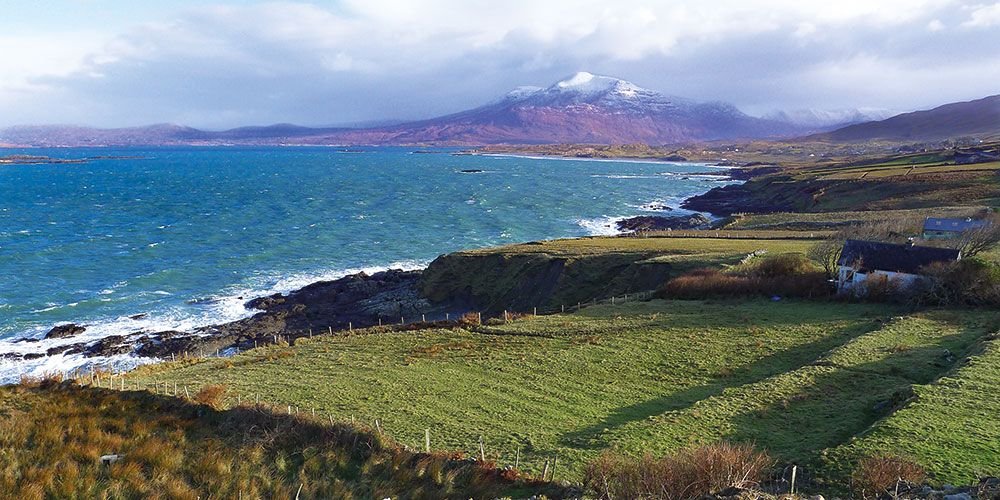
This is Connemara
Contrary to what is often wrongly thought, Connemara is not a county, but a geographical area in the west of Ireland (more precisely, in the County Galway); its extension roughly goes from Lough Corrib to the shores of the ocean. It is traditionally divided into North and South Connemara, the boundary between these two areas is the mountain range of Twelve Bens and the river Owenglin, which flows into the sea at Clifden. The region, with an indented coastline, has beautiful coral beaches, while the inner part is dotted with rivers and lakes quietly lying on the moors.
The landscape we can see today is the result of 750 million years of evolution; 10,000 years ago the region was covered by glaciers, but at the end of the last Ice Age, the area was slowly colonized at first by plants and animals and subsequently by the man, who gave the name of his tribe to this grand landscape: the Gaelic name Conamara derives from Conmhaicne Mara a clan of Conmhaicne located on the coast (its translation would, therefore, be: the Clonmhaicne of the sea).
The area immediately west of Galway has many dry stone walls enclosing small plots of land used as pasture; the cottages - some traditional, some modern - are located along the coast, from which you can reach the Aran Islands in a few minutes of flight. The picuresque village of Carraroe is famous for its traditional fishing boats known as Galway Hookers. During Summer many of them are moored at Sruthán and Caladh Thadhg piers. Further westwards the coastline becomes more and more convoluted, with small islands very close to the mainland and headlands projecting boldly into the sea; the area from Carna to Cashel is particularly picturesque: many islands are accessible by car and are still inhabited. Roundstone , a quaint fishing village, offers picturesque views of the coast and lies at the beginning of a region dotted with a myriad of lakes, sometimes simple pools of water that haven't even a name if not in the folk tradition. This huge bog is delimited by the rounded shapes of the Twelve Bens (Na Beanna Beola in Gaelic), the mountain range that represents an ideal border between North and South Connemara. Going ahead along the coast, in a succession of beautiful beaches, one can reach Ballyconneely , home to a renowned Golf Course. A few kilometres towards the north one can find Clifden, a vibrant small town, traditionally home to a lively market. Today it is a cosmopolitan city, rightfully considered the capital of Connemara, because of its many amenities, shops, restaurants, and pubs.
The coastal area north of Clifden, very rich in pretty hilly peninsulas, continues towards the villages of Claddaghduff, in front of Omey Island, and Cleggan, daily connected to the scenic Inishbofin and Inishhark islands. Leaving the coast, the road goes on to Letterfrack, a charming, small town that is home to Connemara National Park; going inward from here one can reach the romantic and imposing Kylemore Abbey. Heading north past Letterfrack one can find the beautiful Renvyle Peninsula, where there are many pretty villages - Tullycross, Tully, Renvyle - and beautiful coastal landscapes, with famous beaches such as Lettergesh or Glassilaun, on the edge of Killary Harbour. Killary Harbour, whose length is about 16 km, is the only natural fjord in Ireland and separates the Maamturk mountains and the aforementioned Twelve Bens mountains from Mweelrea and Sheefry Hills. Right at the base of the fjord is located Leenane, a picturesque crossroad from which one can reach Westport going to the north, or the internal area of Connemara, with Maam Cross and Recess villages.
From Leenane, travelling through Joyce's country one can reach the great lakes of Connemara: Lough Mask and further southward the gigantic Lough Corrib, dotted with rocky islands such as Inchagoill, where there are some ruins of an ancient monastic settlement and the oldest Irish inscription in Roman letters. The islands are easily reached by a short boat ride from Oughterard, considered the gateway to Connemara, a very lively town crossed by the N59 national road that brings westward to Clifden, or to Galway proceeding to the southeast.
